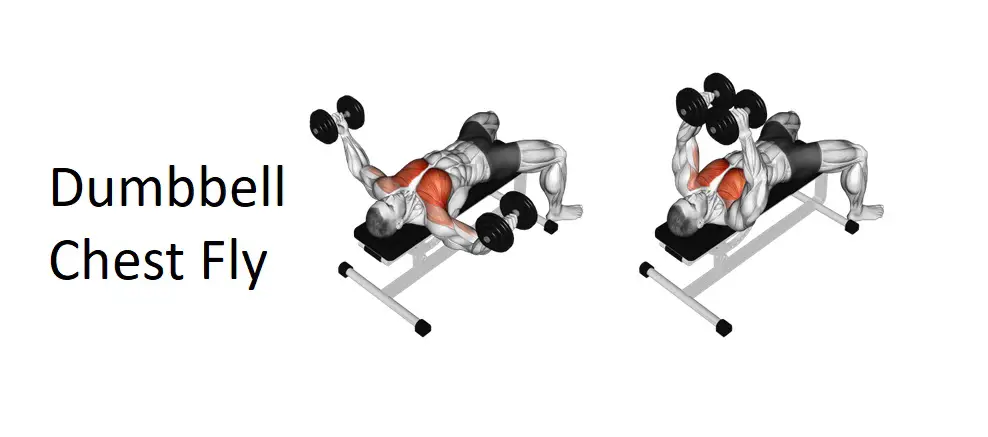The Dumbbell Chest Fly is a powerful isolation exercise that targets the pectoral muscles, primarily the chest, along with engaging the shoulders and biceps. It’s a fundamental exercise often incorporated into strength training and bodybuilding routines to enhance chest development and definition. Utilizing dumbbells, this exercise allows for a wide range of motion, stretching and contracting the chest muscles effectively. In this comprehensive guide, explore the technique, benefits, and alternative exercises related to the Dumbbell Chest Fly.
Instructions
Setup:
- Position: Lie flat on a bench with a dumbbell in each hand. Start with your arms extended directly above your chest, palms facing inward.
- Stance: Plant your feet firmly on the ground for stability throughout the exercise.
Execution:
- Lowering Phase: With a slight bend in your elbows, slowly lower the dumbbells to the sides, keeping your arms extended. Focus on maintaining control and a consistent pace.
- Depth: Lower the dumbbells until your chest feels a comfortable stretch without overextending or straining the shoulders.
- Lifting Phase: Engage your chest muscles to bring the dumbbells back to the starting position. Exhale as you contract the chest muscles.
- Repeat: Perform the desired number of repetitions while focusing on the mind-muscle connection to maximize chest engagement.
- Repetition and Sets: Aim for 3-4 sets of 8-12 repetitions for muscle hypertrophy (growth) and strength endurance. Adjust the weight to maintain proper form throughout each set.
- Breathing Technique: Inhale as you lower the dumbbells, and exhale as you contract your chest muscles to lift the weights back to the starting position. Consistent breathing helps maintain rhythm and control during the exercise.
- Form and Alignment: Focus on form over weight. Ensure your back remains in contact with the bench throughout the movement to prevent strain. Keep your core engaged for stability and avoid arching your back excessively.
Tips:
- Use a controlled motion throughout the exercise to avoid jerking or swinging the weights.
- Keep a slight bend in your elbows to reduce strain on the shoulder joints.
- Focus on the chest muscles’ contraction and extension rather than the weight of the dumbbells.
Benefits of Dumbbell Chest Fly
- Chest Muscle Isolation: The Dumbbell Chest Fly specifically targets the pectoral muscles, aiding in enhancing chest muscle development and definition.
- Stretching and Contracting: The exercise allows for a deep stretch and contraction of the chest muscles, promoting muscle growth and flexibility.
- Shoulder Stability: While primarily a chest exercise, the Dumbbell Chest Fly also engages the shoulder muscles, contributing to improved shoulder stability.
- Muscle Symmetry: Incorporating chest flyes into workouts helps in developing balanced chest muscles, enhancing overall chest symmetry.
- Versatility: Adjusting the angle of the bench or grip position can target different areas of the chest for a varied workout.
- Increased Muscle Activation: The Dumbbell Chest Fly places a significant stretch on the chest muscles, activating muscle fibers that might not be fully engaged during other chest exercises.
- Improved Shoulder Health: While primarily targeting the chest, the exercise indirectly strengthens the shoulder muscles, contributing to improved shoulder joint stability.
- Enhanced Mind-Muscle Connection: Performing chest flyes encourages a stronger mind-muscle connection, allowing you to better isolate and engage the chest muscles during workouts.
- Controlled Progression: By mastering proper form and control with lighter weights, you can gradually progress to heavier weights to further challenge and stimulate chest muscle growth.
Alternatives of Dumbbell Chest Fly
If you seek variations or alternatives to the Dumbbell Chest Fly for a well-rounded chest workout, consider these options:
- Chest Press: Utilizing dumbbells or a barbell, chest presses allow for heavier loads and engage the chest muscles similarly.
- Push-Ups: An effective bodyweight exercise targeting the chest, shoulders, and triceps, suitable for various fitness levels.
- Cable Crossover: Using a cable machine with handles at shoulder height, cable crossovers mimic the fly motion for chest muscle isolation.
- Dips: Chest dips focus on the chest and triceps using parallel bars or a dip machine, offering bodyweight resistance.
- Incline Dumbbell Press: Performing dumbbell presses on an incline bench emphasizes the upper chest muscles.
- Dumbbell Pullover: Engaging the chest, shoulders, and lats, dumbbell pullovers are performed lying perpendicular on a bench, allowing a deep stretch and contraction of the chest muscles.
- Machine Chest Fly: Utilizing a chest fly machine replicates the movement pattern of dumbbell flyes but with more stabilized resistance.
- Wide Push-Ups: Performing push-ups with a wider hand placement targets the chest muscles more intensely.
- Medicine Ball Chest Pass: Standing and forcefully passing a medicine ball engages the chest muscles dynamically while incorporating power and explosiveness.
- Resistance Band Flyes: Mimicking the motion of chest flyes with resistance bands offers continuous tension throughout the movement.
Continuing with these alternatives can add variety to your chest workouts, prevent muscle adaptation, and enhance overall chest strength and definition.








